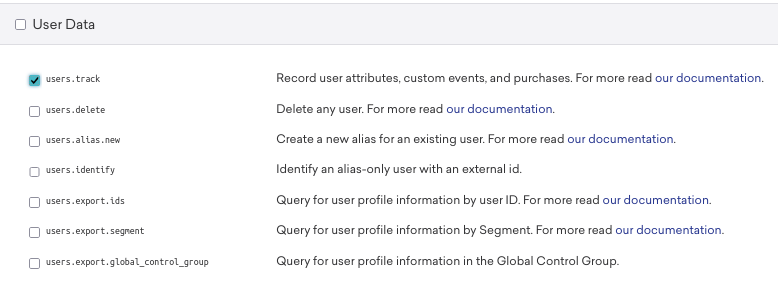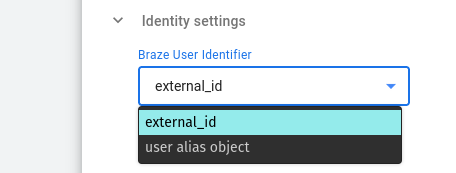Braze Tag Configuration
Configuration options
Braze REST API Endpoint (required)
Set this to the URL of your Braze REST endpoint.
Braze API Key (required)
Set this to your Braze API Key that will be included in each request. The minimum permission that you need to assign for this API Key is to access the /users/track endpoint.

Identity settings
Braze User Identifier
This section allows you to select which Braze user identifier (external user ID (external_id) or User Alias user_alias) will be used by the tag. The default value is external_id.

Braze external_id
This configuration section is enabled if you have selected the external_id as the Braze User Identifier.
Set external_id from:
Use this option to select how you want to set the
external_id, either from the Event Property you specify or directly from the Value you provide.external_id
Depending on the previous selection, here you can specify the value or the client event property (e.g. client_id) that corresponds to the
external_iduser identifier for Braze API.
Braze User Alias Object
This configuration section is enabled if you have selected the user_alias as the Braze User Identifier.

Update existing users only
When enabled(default), this option will only update existing users. Uncheck this box to allow creating alias-only users.
User Alias Name
Set user alias name from:
Using this section you can select how you want to set the name of the user alias object: from an Event Property or directly from a Value you provide.
Alias Name
Depending on the previous selection, here you can specify the value or the client event property that corresponds to the User Alias Name.
User Alias Label
Set user alias label from:
Using this section you can select how you want to set the label of the user alias object: from an Event Property or directly from a Value you provide.
Alias Label
Depending on the previous selection, here you can specify the value or the client event property that corresponds to the User Alias Label.
Snowplow Event Mapping Options
This section includes the mapping rules that concern a Snowplow event as claimed by the Snowplow Client:
Snowplow Self Describing Event

Include Self Describing event
This option indicates if the Snowplow Self-Describing event data will be included in the event's properties object that will be sent to Braze. By default, this option is enabled.
Self Describing Event Location
This section is available only if the Include Self Describing event option is enabled. Using this drop-down menu you can indicate the location where Snowplow Self Describing event properties should be added under Braze event properties. The available options are:
- Nest under schema name (default): The schema name will be used as a key in Braze event properties with the self-describing data as its value.
- Merge to root level: The self-describing properties will be added directly as Braze event properties without nesting.
Snowplow Event Context Rules
This section describes how the Braze Tag will use the context Entities attached to a Snowplow Event.
Extract entity from Array if single element
Snowplow Entities are always in Arrays, as multiple of the same entity can be attached to an event. This option will pick the single element from the array if the array only contains a single element.
Include Snowplow Entities in event object
Using this drop-down menu you can specify whether you want to Include All or None of the Snowplow context entities in Braze's event_object.
Snowplow Entities to Add/Edit mapping
Using this table you can specify in each row a specific mapping for a particular context entity. In the columns provided you can specify:
- The Entity name to add/edit-mapping (required).¹
- The key you could like to map it to (optional: leaving the mapped key blank keeps the same name).
- Whether to add in
event_objectoruser_attributes_objectof the Braze event (default value isevent_object). - Whether you wish the mapping to apply to all versions of the entity (default value is
False).¹
Snowplow Entities to Exclude
Using this table (which is only available if Include Snowplow Entities in event object is set to All), you can specify the context entities you want to exclude from the Braze event. In its columns you can specify:
- The Entity name (required).¹
- Whether the exclusion applies to all versions of the entity (default value is
False).¹
¹ How to specify the Entity Name and its relation to Apply to all versions option:
Entity Names can be specified in 3 ways:
By their Iglu Schema tracking URI (e.g.
iglu:com.snowplowanalytics.snowplow/client_session/jsonschema/1-0-2)By their enriched name (e.g.
contexts_com_snowplowanalytics_snowplow_client_session_1)By their key in the client event object, which is the GTM SS Snowplow prefix (
x-sp-) followed by the enriched entity name (e.g.x-sp-contexts_com_snowplowanalytics_snowplow_client_session_1)
Depending on the value set for the Apply to all versions column, the major version number from the 2nd and 3rd naming option above may be excluded. More specifically, this is only permitted if Apply to all versions is set to True.
Additional Event Mapping Options
If you wish to pick other properties from the Client event and map them onto the Braze event, these can be specified in this section.
Event Property Rules
Include common event properties
Enabled by default, this option sets whether to automatically include the event properties from the Common Event definition in the properties of the Braze event.
Additional Event Property Mapping Rules
Specify the Property Key from the Client Event, and then the properties' object key you could like to map it to or leave the mapped key blank to keep the same name. You can use Key Path notation here (e.g. x-sp-tp2.p for a Snowplow events platform or x-sp-contexts_com_snowplowanalytics_snowplow_web_page_1.0.id for a Snowplow events page view id (in array index 0) or pick non-Snowplow properties if using an alternative Client. These keys will populate the Braze event's properties object.
Include common user properties
Enabled by default, this option sets whether to include the user_data properties from the common event definition in the Braze User Attributes object.
Additional User Property Mapping Rules
Using this table, you can additionally specify the Property Key from the Client Event, and then the User Attribute key you could like to map it to (or leave the mapped key blank to keep the same name). You can use Key Path notation here (e.g. x-sp-tp2.p for a Snowplow events platform or x-sp-contexts_com_snowplowanalytics_snowplow_web_page_1.0.id for a Snowplow events page view id (note the array index 0) or pick non-Snowplow properties if using an alternative Client.
Advanced Event Settings
This section offers additional configuration options on the Braze event object:
Event Name Override
You can use this option to override the name of the Braze event object or leave it blank to inherit from common event properties, which is the default. Please note that the name property of the Braze event object, that this option populates, is a required property according to Braze API.
Event time property
This option enables you to specify the client event property to populate the event time (in ISO-8601 format) or leave it empty to use the current time (default behavior).
Logs Settings
Through the Logs Settings you can control the logging behavior of the Braze Tag. The available options are:
Do not log: This option allows you to completely disable logging. No logs will be generated by the Tag.Log to console during debug and preview: This option enables logging only in debug and preview containers. This is the default option.Always: This option enables logging regardless of container mode.
Please take into consideration that the logs generated may contain event data.
The logs generated by the Braze GTM SS Tag are standardized JSON strings. The standard log properties are:
{
"Name": "Braze", // the name of the tag
"Type": "Message", // the type of log (one of "Message", "Request", "Response")
"TraceId": "xxx", // the "trace-id" header if exists
"EventName": "xxx" // the name of the event the tag fired at
}
Depending on the type of log, additional properties are logged:
| Type of log | Additional information |
|---|---|
| Message | “Message” |
| Request | “RequestMethod”, “RequestUrl”, “RequestHeaders”, “RequestBody” |
| Response | “ResponseStatusCode”, “ResponseHeaders”, “ResponseBody” |